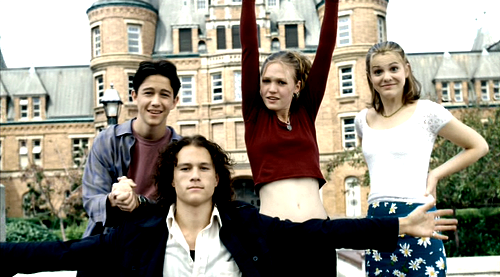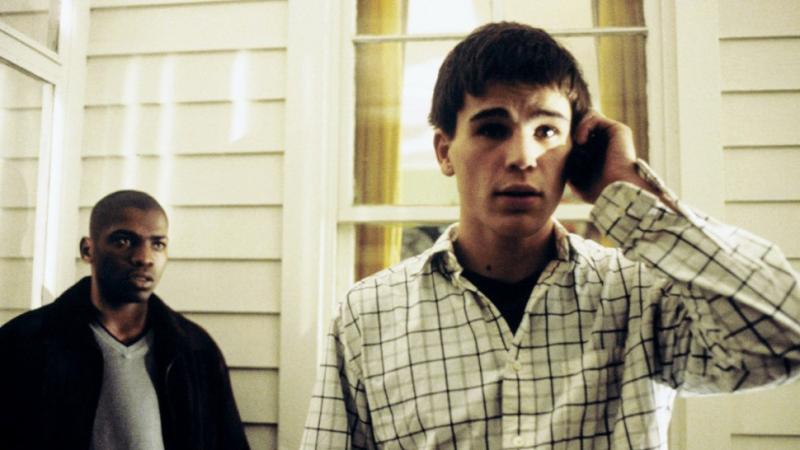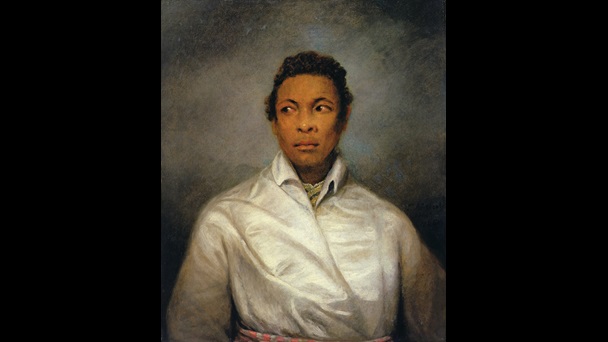Nostalgia Pedagogy and 90s Shakespeare Adaptations; 'Othello' and Tim Blake Nelson's 'O'
Written by Lauren A. Weber in Criticism and Research | 13.05.2019
90s nostalgia is a booming business in the 21st century. The latest Marvel Universe blockbuster ‘Captain Marvel’ is packed with 90s references and music. Contemporary fashion trends cite the 90s as inspiration, and Instagram is awash with 90s trend ‘inspo’. This is perhaps exemplified best by the return of the 'fanny pack' ('bum bag' in Australian parlance). The hashtag ‘90s’ has 13,637,823 posts to date and counting. A browse through the photos and likes associated with each post suggest that a love for the aesthetic and pop-culture of the 90s is not just for Millennials or later generations who lived through the decade. Generation Z is also part of the culture of 90s nostalgia. This is arguably due to Gen Z Instagram literacy where 90s cultural references are a prominent feature, and the close cultural relationship Gen Zs have to Millennials who also venerate the 90s. Kurt Anderson argues that the collective love for the 90s is linked to the rise of American television culture during the decade and a ‘simpler’ political atmosphere before the 9/11 terrorist attacks. The 90s have been deemed the 'golden age' of African American Hip hop music and culture and this culture is incredibly popular with teenagers today. One thing is clear – a general aesthetic taste for all things 1990s is upon us, and as teachers we can lean into this and learn about the interests of our students.
As educators interested in Shakespeare, it is worth pointing out that the 90s were a great time for Shakespeare adaptation. Douglas Lanier's work has revealed the fact that Shakespeare adaptations and pop-cultural references were at their peak in the 1990s, particularly in the American context (Shakespeare and Modern Popular Culture 2002, ‘Shakescorp Noir’ 2002). He argues that Shakespeare on film in the 1990s:
Pushed hard against the textual conceptualization of Shakespeare that was the dominant keynote of much of the twentieth century, the notion that Shakespeare’s essence is to be found in the particularities of his language. One of the main achievements of the nineties was to bring Shakespeare in line with late twentieth-century visual culture and in the process loosen the equivalence between Shakespeare and text. Through film of this period Shakespeare became definitively post-textual. (‘Recent Shakespeare Adaptation and the Mutations of Cultural Capital’ 106)
He goes on to detail the way this shift from word to image relates to the speed at which culture was becoming visual (106). Lanier attributes the popularisation of pushing the plays into a contemporary setting on stage to the films of the 1990s. These films include: Baz Luhrmaan’s Romeo + Juliet (1996), Gil Junger’s 10 Things I Hate About You (1999), Tim Blake Nelson’s 0 which was scheduled for release in 1999 but was delayed until 2001 due to the Columbine massacre, John Madden’s Shakespeare in Love (1998), Julie Taymor’s Titus (1999) and the various Kenneth Branagh adaptations that solidified his career: Much Ado About Nothing (1993), Othello (Directed by Oliver Parker with Branagh as Iago, 1995), and Hamlet (1996). While these adaptations vary in their approaches to Shakespeare’s language, Lanier points out the fact that in this context Shakespeare ‘becomes a collection of narratives highly mobile from context to context, verbal style to style, genre to genre, media platform to platform’ (107).

10 Things I Hate About You, Gil Junger (1999)
Helpful for pedagogy, Lanier points out the fact that ‘because students find film appealing and familiar, screen Shakespeare has done much to make Shakespeare seem less forbidding, even hip, so much so that including videos in one’s Shakespeare classroom now seems compulsory’ (‘I’ll teach you differences’: Genre Literacy, Critical Pedagogy, and Screen Shakespeare’ 257). Lanier recognises the complex choice of using Shakespeare on film in the classroom as ‘both a potential pedagogical trap and an opportunity’ (259). For him, the trap involves the limitations of genre on film and the risk of ‘reinforcing the cultural dominance of those genres along with the ideological baggage they bear’ while the opportunity lies in using the films and their generic conventions to unpack what he calls Shakespeare’s ‘creative reshaping’ of genre in his milieu, and the ‘work of contemporary film genres on our own imaginations’(260). What follows in this post is an exploration of how Shakespeare’s Othello both fulfils and subverts the genre of domestic tragedy, while Tim Blake Nelson’s O explores new thematic terrain through the ‘teen film’ genre. My readings are influenced by Lanier’s argument:
What I am advocating is using popular adaptations in a way that restores to Shakespeare some of his potential for cultural critique, but without re-erecting Shakespeare as some sort of cultural standard. What I am advocating is more attention to the way in which Shakespearean content (indeed, any content) does not smoothly travel between media or across genres. The differences matter because the particular pressures that genre and media exert are the message. (268)
With this in mind, I turn to the play and its adaptation.
Othello is a genre bending work. It draws on comedy, tragedy and the domestic tragedy, and blends these together to craft something wonderfully complex and new for the period (Norton Shakespeare, Cohen 2111) . However, the status of the play as a domestic tragedy is a controversial one (Benson, Shakespeare, Othello and Domestic Tragedy 2012). For purposes of exploration, I align the argument of this piece with the work of Sean Benson in calling Othello a domestic tragedy. While domestic tragedies are usually associated with those of the general public rather than nobility, there is something to be said – as Benson does – of Othello’s otherness and the relationship his fall has to the domestic horror that ensues. As Benson points out, the clearest feature of the domestic tragedy is ‘spousal murder’ and the use of domestic objects to commit murder; in this case the handkerchief (as a vehicle of the murder) and the pillow as weapon (97-100). Another important feature of the domestic tragedy is the constant state of flux the characters are in when it comes to social status. This is exemplified in the play by Iago and Cassio’s relationship and motivations, and the relationship Othello has to nobility and ‘breeding’ (Benson 100-105).
Where Shakespeare does the interesting generic work in subverting the genre is in Othello’s otherness. At the centre of the play is the question of what types of action outweigh other types of action, and for whom. This is exemplified in Othello’s reply to Iago regarding Brabanzio’s disapproval of Othello’s marriage to Desdemona:
Let him do his spite.My services which I have done the signoryShall out-tongue his complaints. ‘Tis yet to knowWhich, when I know that boasting is an honour,I shall promulgate – I fetch my life and beingFrom men of royal siege, and my demeritsMay speak unbonneted to as proud a fortuneAs this that I have reached. For know, Iago,But that I love the gentle DesdemonaI would not my unhousèd free conditionPut into circumscription and confineFor the seas’ worth. (Norton Shakespeare, Second Edition, 1.2, 18-28)
'A Moor' by James Northcote (1862)
Ira Aldridge, the first black actor to play a Shakespearean role in Britain.
Courtesy of the Bridgeman Art Library / Manchester Art Gallery
There are three different kinds of action stacked on top of one another, and all of them are fighting to give Othello the credibility he needs to win the affections of Brabanzio (18-20). These actions are all complicated by the underlying issue of Othello’s otherness. First, he draws attention to his ‘service’ for the Venetians, a people whom he is othered by and expresses how this dedication should ‘out-tongue’ the complaints of a Venetian like Brabanzio. The use of the word ‘service’ is also complicated because it draws on the fact that Othello is in service of others while still being othered by those he serves. Then he draws on the fact that he shall ‘promulgate’ or publicly proclaim (OED) how he draws his ‘life and being’ from ‘men of royal siege’ (21-22). This is an ambiguous claim. Othello might mean he fetches his ‘life and being’ by killing men of royalty on the battle field, or he is built up by men of royalty by fighting for them. In both cases, there is a tension between the give and take nature of these actions, and the way Othello has to express his credentials in order to move beyond his racial mark as ‘Moor’. His credibility must be built by external sources rather than his interiority or personal virtue. Following this building of credibility by referencing others, Othello ties up his reasoning with perhaps the most important admission – his love of Desdemona. Paradoxically, this is the most credible element of Othello’s person in the particular situation of marriage. It is something difficult to externalize, and the externalization of his love becomes a poisonous one when left in the hands of Iago. As we know – it is the intensity of Othello’s love that turns the play into a tragedy. A clearer way to track this stack of social/moral CV building is:
1. Othello’s ‘service’
2. His relationship to others (by means of killing or killing for)
3. His love for Desdemona
- All underlined by his race
These lines are helpful when placed in contrast to the domestic tragedy as a genre. If domestic tragedy is ‘a kind of tragedy in which the leading characters belong to the middle class rather than to the royal or noble ranks’ and ‘in which the action concerns family affairs rather than public matters of state’ (Oxford Dictionary of Literary Terms) it is useful to think through the ways in which Othello’s relationship to himself as ‘other’ in Venice and to others (Venetians) is both supported and undermined by the generic conventions at work, and Shakespeare’s role as genre bender.
Keeping the theme of actions and their weight in opposition to interiority and its merit, I turn to Tim Blake Nelson’s film O. The film went through a difficult release process. While editing began in April of 1999 the film was not released until 2001 due to the Columbine High School mass shooting which took place on April 20, 1999. O had to change hands from Miramax to Lion’s Gate Films in order to acquire distribution following lawsuits and political pushback (Gregory M. Colón Semenza, ‘Shakespeare after Columbine: Teen Violence in Tim Blake Nelson’s O’ 100). In 2019, we think of Miramax in a different way due to the fact that it was founded and owned by the Weinstein brothers.
As Semenza points out, there were more than a few school shootings that had taken place in America before the production of O began (Olivehurst, San Diego, Craighead County, Littleton Colorado). Nelson was aware of this and wanted to depict and investigate teen violence in his adaptation of the play (100). The tension involving the release of the film was related to the belief that films depicting teen violence would potentially incite more violence in real life (Semenza 99-101). However, as Semenza points out this perpetuates the idea that ‘readers of the film, especially young ones, are not critically astute enough to understand what they are watching’ (100). As Roger Ebert wrote in his review of the film:
We have a peculiar inability in our country to understand the contexts of things; when it comes to art, we interpret troublesome works in the most literal and simple-minded way. In the aftermath of Columbine, Washington legislators called on Hollywood to police itself, and rumbled about possible national censorship. To suggest that “O” was part of the solution and not part of the problem would have required a sophistication that our public officials either lack, or are afraid to reveal, for fear of offending the bottom-feeders among their constituents. (Roger Ebert, August 31 2001)
This tension between what is depicted in art and what type of action it might inspire is an added layer to Nelson’s O that might be interesting to talk about with students. The contemporary climate in the United States regarding gun violence is well known and observed by young people all over the globe. Discussing the purpose, limits and responsibilities of art with students in light of the history of the film has the potential to inspire thoughtful conversation and reflection on what art means to them and what they think it should be able to do and say.
Now, to the film itself. Nelson’s O is arguably a ‘teen film’. It is set in an American high school (a presumably expensive, private boarding school) called ‘Palmetto Grove Academy’ in the American south. The location of the school is distinguished by the various shots of Spanish moss hanging from trees and the porch-centric architecture of homes in the film, both signifiers of the ‘bible belt’. The cast of the film is also an important contributor to the genre label of ‘teen film’. Julia Stiles who plays ‘Desi’ was one of the most popular teen actresses of the 90s and appeared in another teen Shakespeare film 10 Things I Hate About You (1999). Both Mekhi Phifer (‘Odin’/Othello) and Josh Hartnett (‘Hugo’/Iago) were considered teen heart-throbs of the decade, along with another cast member from 10 Things – Andrew Keegan as Michael Cassio. That being said, the film subscribes to a variety of ‘teen film’ genre tropes on its own. Catherine Driscoll provides a list of conventions that help identify teen film:
The youthfulness of central characters, content usually centred on young heterosexuality, frequently with a romance plot; intense age-based peer relationships and conflict either within those relationships or with an older generation; the institutional management of adolescence by families, schools, and other institutions; and coming of age plots focused on motifs like virginity, graduation, and the makeover. (Teen Film: A Critical Introduction, 2011)

O, Tim Blake Nelson (2001)
Nelson’s film subscribes to all of the above. Hugo (the Iago character) has a turbulent relationship with his father Coach Duke Goulding (played by Martin Sheen) because he isn’t as good at basketball as Odin (Othello). Roger (Rodrigo) is bullied by the popular students – Michael Cassio and his friends. Desi loses her virginity to Odin and her father (played by John Heard) is not happy about it. Emily (Emilia) is duped by Hugo’s promises of affection in light of her constant exposure to Desi and Odin’s exhibitionist behaviour in the girls’ shared dorm room. However, as you might notice – the only real difference here between the film and the source text is the fact that Hugo is the son of the Duke in the film, and so the ‘institutional management of adolescence by families’ trope is heightened by contributing to Hugo’s motivations to take down Odin.
The film’s plot rolls out very close to the play even with its teen tweaks. I won’t summarise the plot – the film is more than worth watching. Instead, it might be helpful to think about the final scene of the film in light of both its tumultuous history, the film’s genre, and the source text which is also interested in action, interiority and what counts to the community who makes judgements.
Just before this clip begins, Odin has just realised that Hugo has been deceiving him. Odin points the gun at another student, a white one, in an attempt to force Hugo to be truthful to him. Hugo then responds in a culturally appropriated way by using African American Vernacular English: ‘you won’t ask me nothing’. The scene itself is a close approximation of Iago and Othello’s final exchange in the play. Othello asks Cassio to ask Iago why he has committed the crimes of manipulation and murder:
Cassio: Dear general, I never gave you cause.Othello: I do believe it, and I ask your pardon.Will you, I pray, demand that demi-devilWhy he hath thus ensnared my soul and body?Iago: Demand me nothing. What you know, you know.From this time forth I never will speak word. (5.2 305-309)
Othello’s ‘Speak of me as I am’ (5.2 351) speech is contemporised by Odin in an equally powerful way. He uses the phrase ‘my life is over’ in a doubled sense. He means that his memory is ruined because of racism in America – evidenced by his use of the ‘n word’ and the fact that his life is about to be over in death by his own hand. Before he takes his own life he reverses all of the stereotypes associated with black teens and guns:
I ain’t no different than none of y’all. My Moms ain’t no crackhead, I wasn’t no gangbanger, it wasn’t some hoodrat drug dealer that tripped me up. It was this white, prep-school motherfucker standing right there. You tell them where I’m from didn’t make me do this. (Brad Kaaya)
Tragically, Odin is aware of the fact that because of his action as a black teenager in America his interiority and his words have no chance in extending far enough to the public perception of his crime. This is a wonderfully different way of approaching Othello’s final speech. In the original source text, Othello’s final lines involve the complexity of his racial status – he is both a Jew and a Turk in his circumcision: ‘I took by th’ throat the circumcised dog / And smote him thus [He stabs himself]’(5.2 364-365). It is also a major question in criticism on the play – are these final lines solidifying or undermining Othello’s status as a racial stereotype? Nelson’s film does more to explicitly undermine racism and the way stereotypes determine perceived actions with complete disregard for interiority. However, both texts still depict the horrifying and inexcusable crime of domestic and sexual violence. There is no way out for anyone involved (including us in the audience) except perhaps – Hugo/Iago.

O, Tim Blake Nelson (2001)
Students who are hesitant to engage with Shakespeare might find an entry point here through their cultural familiarity and experiential unfamiliarity with 90s culture and aesthetics. Both Shakespeare’s Othello and Nelson’s O warp and expand on generic tropes in order to complicate the relationship between action and interiority. In light of the discussion here, I will leave you with this quote from Nelson, and urge you to reflect on how our students are still interested in 90s culture and American hip-hop, a genre created and popularised by African Americans, and how we can use the complexity of both the original text and its adaptations to discuss what is going on in teens’ minds and on their screens:
The facts, as concern the story's racial elements, are far more intriguing than the fiction. One irony of American hip-hop culture is that white suburban kids strive to emulate the inner city tastes in dress and manner of speech that are described in rap music or depicted in its videos. Teenagers in the South are as hip-hop as they are Southern, making Odin far easier for students to venerate and therefore far easier for Hugo to envy. Just as Othello first catches Desdemona's attention because her father can never tire of the Moor's stories of ''hairbreadth 'scapes i' th' imminent deadly breach,'' so Odin's peers at Charleston's (fictional) Palmetto Grove Academy would worship rather than fear this singular embodiment of hip-hop culture in their midst. (Tim Blake Nelson, ‘FILM; There’s a Price You Pay for Getting Too Real: Delay’, The New York Times, online archives 2001)
Works Cited:
- Baldick, Chris. 'domestic tragedy'. The Oxford Dictionary of Literary Terms. : Oxford University Press, January 01, 2015. Oxford Reference. Date Accessed 13 May. 2019
- Benson, Sean. Shakespeare, 'Othello' and Domestic Tragedy. 1st ed. Bloomsbury Publishing, 2011. Print.
- Driscoll, Catherine. Teen Film : a Critical Introduction . Oxford: Berg, 2011. Print.
- Ebert, Roger. O. www.rogerebert.com/reviews/o-2001, August 31, 2001.
- Lanier, D.M. ‘I’ll Teach You Differences": Genre Literacy, Critical Pedagogy, and Screen Shakespeare'. Shakespeare and Genre: From Early Modern Inheritances to Postmodern Legacies. Palgrave Macmillan, 2012. 257–270. Web.
- Lanier, Douglas. 'Recent Shakespeare Adaptation and the Mutations of Cultural Capital'. Shakespeare Studies 38 (2010): 104–113. Web.
- Lanier, Douglas. Shakespeare and Modern Popular Culture . Oxford: Oxford University Press, 2002. Print.
- Lanier, Douglas M. 'Shakescorp Noir'. Shakespeare Quarterly 54.2 (2003): 157–180. Print.
- 'promulgate, adj.' OED Online. Oxford University Press, March 2019. Web. 13 May 2019.
- Nelson, Tim Blake. 'There’s a Price You Pay for Getting Too Real: delay.(Tim Blake Nelson’s ‘O’ to Open in Theaters Soon).' The New York Times 26 Aug. 2001: n. pag. Print.
- Semenza, Gregory M. Colón. 'Shakespeare after Columbine: Teen Violence in Tim Blake Nelson’s O' . College Literature 32.4 (2005): 99–124. Web.
- Shakespeare, William et al. The Norton Shakespeare . 1st ed. New York: W.W. Norton, 1997. Print.

